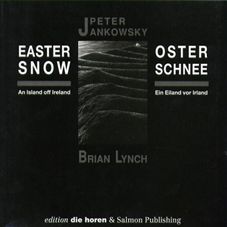
EASTER SNOW
Bremen, die horen and Galway, Salmon Press, 1992
Poems by Brian Lynch with photographs by Peter Jankowsky. Translated into German as Oster Schnee –Ein Iland vor Irland.
Another book with a less than happy publishing history. As it was being prepared for printing, Jessie Lendennie’s Salmon Press was in grave financial difficulties and in the process of being taken over by Philip MacDonagh’s more commercial Poolbeg Press. The result was the book was poorly distributed and scarcely noticed. However, Michael Viney wrote about it warmly in The Irish Times.
Sadly, too, the quality of the reproduction of Peter’s photographs is not the best – they deserve better and I have often thought that either a new edition or an exhibition of the photos and the poems together would be a good idea.
When I wrote the majority of the poems I had never been on Clare Island, so the book is, for my part, purely, or impurely, formal.
The poem reproduced below describes a carved head in the Abbey on Clare Island – when I saw it the abbey was open to the four winds and one could only dimly see the frescoes on the ceiling through moss and mould. These extraordinary works, almost all of them secular rather than religious, have now been restored after many years of labour by Christoph Oldenbourg and others and can be seen in the Royal Irish Academy volume devoted to the fourth Clare Island survey. The images do not appear to be on the web, which is unfortunate, not least because the interpretation of their meaning is still uncertain and their significance in the iconography of European art history would seem to be great.
[Update: some pictures of the conservation are now on the web. Conservation work on the Abbey]
The Face
1.
This is a religious object,
Which means it’s hard to find,
In the ruined Cistercian Abbey
At Cille on Clare Island.I’d searched and couldn’t see,
Yet when my German friend,
Whose photograph this is,
Showed me it was obvious,
This hidden thing, and godly.2.
The stone on which it’s carved
Is stuck into a wall, waist
High, the first block
That butts the arch
Above the bishop’s throne,
The sedilia, as it’s known.
The other blocks that make this up
Are otherwise unmarked
With carving, and this is odd
Since as the face is side-
Ways to the vertical,
You’d think it would repeat
Until the curve were capped
And held together by
An image of the Lord.
It does not. It’s on its own.3.
The face is mantled with a mould,
A shawl of blooming stuff, a moss
More tightly napped and emerald
Than baize. It’s earlier than the church
And probably was used by chance,
Because it fitted into place.Because it was there and fits here.
This is an answer to anxiety,
A definition of the art of poetry.For this face, as you can see,
Opens its mouth and sings or cries
Or shouts the glory of its maker –
In art there is no difference
Between our grief and joy: it’s all,
In high or low or no, relief.
In life there’s no confusing them.4.
Being sideways and damaged round
The eye and nose does not affect
Its wholiness. Instead it adds to it,
As a lover sees on the beloved’s neck
A bruise and knows who made it
And for that reason will not forsake her,
The wounded creature of the day
Displaying what their night approved….5.
Nor do I disregard, being blind
To grammar, the ambiguity above:
I knew then whose was this photograph.
This is a German face you’re looking at –
And a poet’s too and also yours,
If you have come to be this hard to find,
All those who ever have been moved
By god, the sex of art, or earthly love.
